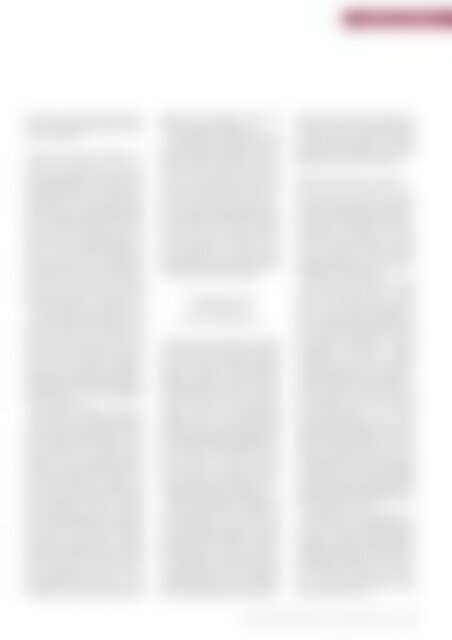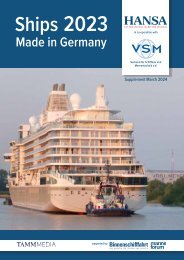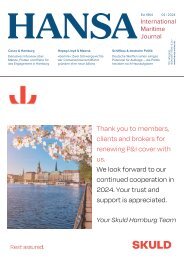HANSA 01-2019
Speditionen | Windantrieb | Tanker-Report | RAVE | Bilanz deutscher Häfen | Hyperloop | Fokus Bunker & Schmierstoffe | Shortsea | dship | Hansa Heavy Lift | Review HANSA-Forum
Speditionen | Windantrieb | Tanker-Report | RAVE | Bilanz deutscher Häfen | Hyperloop | Fokus Bunker & Schmierstoffe | Shortsea | dship | Hansa Heavy Lift | Review HANSA-Forum
Erfolgreiche ePaper selbst erstellen
Machen Sie aus Ihren PDF Publikationen ein blätterbares Flipbook mit unserer einzigartigen Google optimierten e-Paper Software.
Schifffahrt | Shipping<br />
this fall was not driven by a significant increase<br />
in cargo loadings, but by a stabilization<br />
in fleet size.«<br />
Sanctions, trade wars, OPEC cuts<br />
Besides that, political factors seem to become<br />
a major influence in 2<strong>01</strong>9. Sanctions<br />
prohibiting business with Iranian ports,<br />
the country’s energy sector and purchasing<br />
of Iranian oil and oil products came<br />
back into force in early November. BIM-<br />
CO sees changing trade lanes caused by<br />
the US sanctions. »A shift away from Iran<br />
primarily to other Middle Eastern exporters<br />
doesn’t change trading patterns<br />
much, as barrels will be switched with<br />
heavy sour crude oil of a similar quality,«<br />
BIMCO said in a recent report. Elsewhere<br />
in the world, Libya is scaling up<br />
production and the US has set a record<br />
for crude oil exports to all nations other<br />
than China for seven months in a row.<br />
In August and September 2<strong>01</strong>8, when<br />
previous number one purchaser China<br />
took zero US crude oil, American exporters<br />
had to seek new buyers that were<br />
found in the Atlantic Basin and in the<br />
Far East. The new number one long-distance<br />
buyer, South Korea, has helped in<br />
keeping tonne-mile demand almost unchanged<br />
from July 2<strong>01</strong>8’s record high. In<br />
China’s absence, Canada has emerged as<br />
the new top buyer.<br />
Smith expects Middle East crude production<br />
and exports to decline in the nearterm<br />
as Iranian sanctions bite and OPEC<br />
cuts intensify in Q1 2<strong>01</strong>9. OPEC+, the cartel<br />
and a coalition led by Russia, plans to<br />
reduce production by a combined 1.2 mill.<br />
barrels per day, starting from January<br />
2<strong>01</strong>9. Some analysts think that 2<strong>01</strong>9 VLCC<br />
rates might suffer from the global production<br />
cuts while ohers expect the impact<br />
to remain only limited. According<br />
to Clarksons Platou Securities, the buildup<br />
of US pipeline capacity (2 mill. barrels<br />
by the end of 2<strong>01</strong>9) will provide long-haul<br />
volumes form the US Gulf. In combination<br />
with several other factors – less fleet<br />
growth than compared to 2<strong>01</strong>6 (when the<br />
last round of cuts was decided), expected<br />
refinery demand due to a low oil price –<br />
this could make up for the losses. »Continued<br />
growth in US crude exports, which<br />
exceeded 3 mill.b/d in late November, are<br />
adding long-haul demand,« MSI’s Tim<br />
Smith says, supporting this view.<br />
VesselsValue’s Court Smith has taken a<br />
closer look at the possible impacts of the<br />
announced OPEC production cuts. VV<br />
believes that they will have a negative<br />
impact on the earnings of VLCCs in the<br />
short run, but may boost Suezmax and<br />
Aframax demand in the medium term.<br />
The current round of OPEC cuts was enacted<br />
in late 2<strong>01</strong>6 to put upwards pressure<br />
on oil prices, and have been successful<br />
at that goal. Now that prices are falling<br />
again, cuts are back on the table. OPEC<br />
cuts will reduce the number of VLCC<br />
cargoes available in the Arabian Gulf,<br />
encouraging owners to position ships in<br />
other primary load regions such as West<br />
Africa, Brazil, and the Caribbean.<br />
»Looking into 2<strong>01</strong>9,<br />
much depends on<br />
the level of demolition«<br />
A decisive factor in 2<strong>01</strong>9 will once again<br />
be fleet growth. MSI expects the balance<br />
between tanker supply and demand<br />
growth in 2<strong>01</strong>9 to be tight. »Demand<br />
growth is unlikely to be exceptional, although<br />
growth will improve on 2<strong>01</strong>8,<br />
with continued increases in crude flows<br />
from the Americas to Asia being a key<br />
support.« MSI views continued high<br />
scrapping levels in 2<strong>01</strong>9, comparable to<br />
2<strong>01</strong>8, as crucial for sustaining the market<br />
improvement, suppressing supply growth<br />
and allowing underlying market utilisation<br />
to improve. »Lower levels of scrapping<br />
are a risk to our forecast, whilst the<br />
macroeconomic environment also appears<br />
vulnerable, threatening underlying<br />
oil demand growth,« Smith says.<br />
BIMCO expects fleet growth for oil product<br />
and crude oil tankers to be higher than<br />
in 2<strong>01</strong>8. »Mostly for the crude oil sector as<br />
it swings back from very low to 2-3%. This<br />
is the real challenge,« Sand says. For the oil<br />
product tanker fleet, BIMCO’s 2<strong>01</strong>9 fleet<br />
growth forecast is at 2.4%, with deliveries<br />
and demolitions both falling. According<br />
to BIMCO, the crude oil tanker fleet<br />
increased by 0.9% in 2<strong>01</strong>8. »Looking into<br />
2<strong>01</strong>9, much depends on the level of demolition.<br />
Following three low months of ordering<br />
activity from June to August, September<br />
saw owners and investors showing<br />
a renewed interest in crude oil tanker tonnage.<br />
The combined order for 1.7m DWT<br />
of Suezmax (5) and Aframax (8) was the<br />
highest since June 2<strong>01</strong>7,« says Sand.<br />
Difficult but significantly better<br />
The recent upturn in markets corroborates<br />
MSI’s view of 2<strong>01</strong>8 as the nadir in<br />
the market. »Although we expect the levels<br />
of spot earnings attained in November/December<br />
– which have been exceptional<br />
for some sizes/markets – to recede<br />
in Q1, overall MSI forecasts 2<strong>01</strong>9 tanker<br />
markets to improve on 2<strong>01</strong>8, with earnings<br />
significantly better on an annual average<br />
basis,« says Tim Smith.<br />
In contrast, Peter Sand says: »In spite<br />
of the strong market seen since early<br />
October for crude oil tankers, we have<br />
seen no massive change to fundamentals.<br />
We expect 2<strong>01</strong>9 to be a difficult year<br />
for the crude oil sector, mostly due to the<br />
once-again-increasing fleet size – but also<br />
due to demand not foreseen to be much<br />
stronger than a ›normal year‹ – which is<br />
no higher than 2%.« For the oil product<br />
market, the development since Mid-November<br />
has been positive, somewhat connected<br />
to the lift in crude oil tankers. A<br />
pick up in business arrived as refined oil<br />
is redistributed. »Patience is the key to<br />
success in both sectors – the second half<br />
may bring around better rates – as seasonality<br />
will be combined with the leadup<br />
to the IMO2020 deadline on 1 January<br />
2020,« Sand explains. This view is supported<br />
by Smith: »We expect the recovery<br />
to continue into 2020, further supported<br />
by IMO regulations and associated higher<br />
refining runs, sweet crude demand and<br />
product redistribution and logistical demand.<br />
These issues will become increasingly<br />
important in H2 19.«<br />
Overall, sentiment among tanker owners<br />
is improving – in spite of many uncertainties.<br />
According to the latest Shipping<br />
Confidence Survey of consultancy Moore<br />
Stephens, the number of respondents expecting<br />
higher freight rates over the next<br />
twelve months in the tanker market was<br />
up by 7% on the previous survey to now<br />
60%, while those expecting lower rates<br />
was up from 9% to 12%. fs<br />
<strong>HANSA</strong> International Maritime Journal – 156. Jahrgang – 2<strong>01</strong>9 – Nr. 1 53


















